Having a neatly organized tool chest can make all the difference when it comes to finding the right tools for any job. Not only will you be able to easily find what you need, but an orderly space is also a sign of professionalism and respect for your craft.
Organizing a tool chest isn’t difficult; it just requires some forethought and planning. By taking the time to properly organize your tools, you’ll save yourself time and frustration in the future. In this article, we’ll go over how to arrange your tool chest so that everything has its place. We’ll cover organizing by type/functionality, grouping similar items together, using dividers or trays, labeling drawers and compartments clearly, keeping frequently used items within easy reach, and more.
Table of Contents
Tool Organization Products
When it comes to organizing a tool chest, there are a variety of products that can help make the job easier. Dividers, trays, and drawer inserts are all great for helping create an organized space where tools are easily accessible. For example, you can use adjustable dividers to separate tools into different sections. This allows you to quickly and effortlessly locate the precise tool that is required, bypassing the need for rummaging through all of your drawers.
Drawer organizers are also great for keeping items separated and easy to locate. You can use them for nuts, bolts, screws and other small parts that may otherwise get lost in a jumble at the bottom of a drawer. Finally, consider using pegboard or tool rails to hang tools that need to be within easy reach. [1]
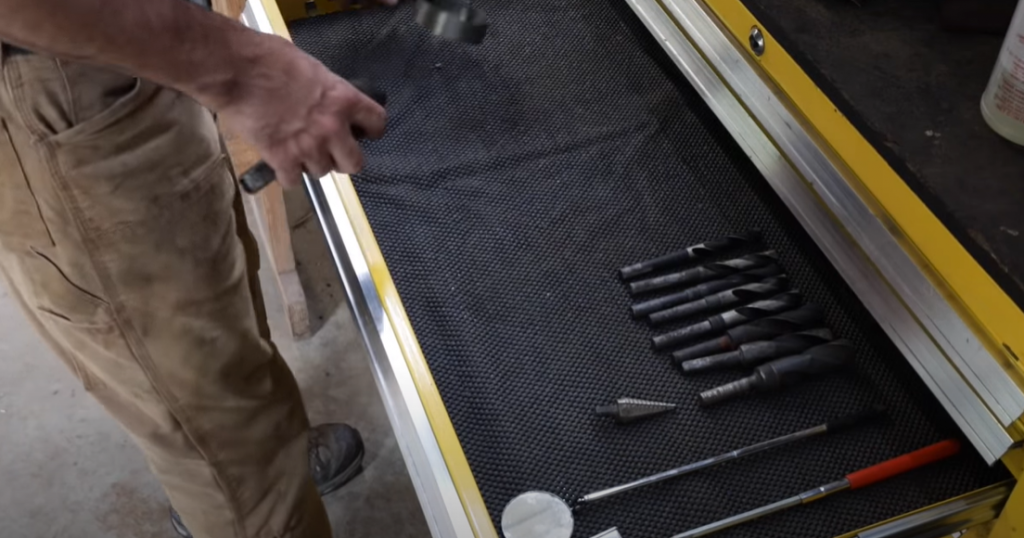
Steps To Organize Your Toolbox
Let’s take a closer look together at how you can organize the space of your toolbox so that everything fits in there and is convenient.
Audit Your Tools
The first step to organizing your tool chest is to take stock of what tools you have and need. A detailed audit of your tools will help you make decisions about which storage solutions are best for you. Carefully analyze each tool’s size and shape so that when you organize them in the tool chest, it will be effortless to identify where they go.
Group Tools By Type And/Or Function
Establishing an orderly system in your tool chest not only ensures the security of your tools, but also helps you stay organized and productive. Organizing tools by type and/or purpose streamlines the process of finding the right tool for whatever task you have in front of you. Use dividers or boxes to separate tools like wrenches from pliers or screwdrivers from hammers. With this tool, you’ll be able to easily locate the ideal instrument when it’s time for you to use it. Furthermore, classifying each set of tools will make it simpler for everyone to locate what they need in the shop or garage.
Organize By Size, Shape, And Frequency Of Use
The perfect way to keep your tools in order is by categorizing them based on size, form, and utilization frequency. This will facilitate you in swiftly finding the tool you need without having to navigate through a range of disparate items. Begin by sorting all similar sized tools together, such as wrenches or screwdrivers. Sort the wrenches in decreasing order of size, beginning with the smallest. Additionally, you can further organize based on the frequency of use. To determine which tools are most often used, take a look at the condition of each tool—the more worn it is, the more frequently it’s likely to be used. Put your most regularly used items in the most convenient drawers or shelves for easy access.
Store Extra Tools Elsewhere
Once you have everything in your tool chest sorted and organized, it is important to store extra tools elsewhere. This prevents overcrowding of your tool chest and makes sure that the most frequently used tools are easy to access. Consider getting an additional storage bin or box for any overflow items or those that aren’t as often used. You can also create a wall-mounted tool storage system to hold larger tools like hammers and wrenches. This will provide extra space and help you keep your tool chest neat and organized. It’s also helpful to label all of your tools, bins, boxes, etc., so that you can easily find what you need when it’s time to work.
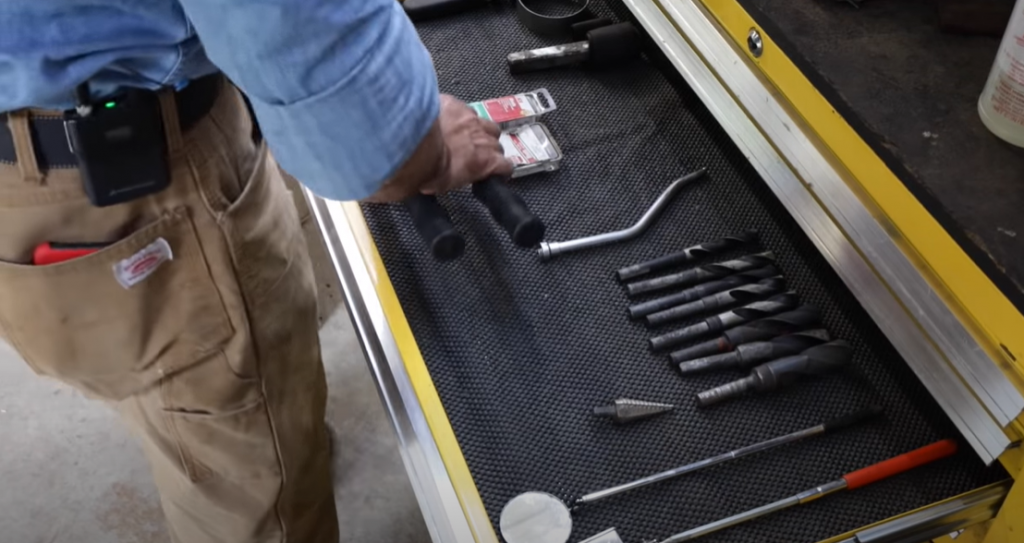
Choose Your Type Of Storage
If you are looking to organize a tool chest, one of the first decisions you must make is what type of storage system you want. There are many different styles and sizes available on the market, so it is important to do your research and find something that meets your needs. Wall mounted systems can help reduce clutter in smaller spaces, while heavier-duty roller carts are great for larger areas.
Label Sections And Tools
To help you stay organized, label each section of your tool chest and the parts within it. This will make it much easier to find what you’re looking for in a hurry. It’s also helpful to group similar tools together, such as all screwdrivers in one spot or wrenches in another. If possible, attach small magnets to the sides of the drawers to keep small parts from sliding around. To further organize your tool chest, color code each type of tool so you can easily identify it when needed. For example, designate red for ratchets and sockets, blue for pliers and wrenches and yellow for screwdrivers. Consider labeling your tools with a numbering system and accompanying legend or chart positioned on the exterior of your tool chest for quick reference. This will expedite the process of finding the perfect tool with ease. [2]
Start Storing Your Tools The Right Way
Once you have all of your tools together, it’s time to start organizing them. There are different approaches to doing this, but generally speaking, you should begin by sorting the tools according to size and type. For instance, you could easily organize your screwdrivers, pliers and wrenches together while conveniently allocating space for hammers and other bigger tools in another compartment. This will help you easily locate the tool you need without having to rummage through your chest.
In addition, consider investing in some organizers for your tool chest that can help divide and organize smaller tools like screws and nails. Plastic trays with compartments are a great way to store these items, as you can quickly and easily find the right item. [3]
Benefits Of Organizing Your Toolbox
Organizing your tool chest comes with many benefits. Here are some of the most important ones:
- Time Savings – Having an organized tool chest can help you save time because you know exactly where each tool is located and don’t have to waste time searching for them when you need them.
- Better Access – An organized tool chest also makes it easier to access the tools needed. It can help you save time and energy, as you don’t have to dig through an overflowing box of tools trying to find what you need.
- Safety – Properly organizing your tool chest helps keep hazardous tools away from children or other people who may come in contact with them and be at risk of injury.
- Consolidation – With a well-organized tool chest, you can easily see what tools you own and don’t have to purchase duplicates unnecessarily. [4]
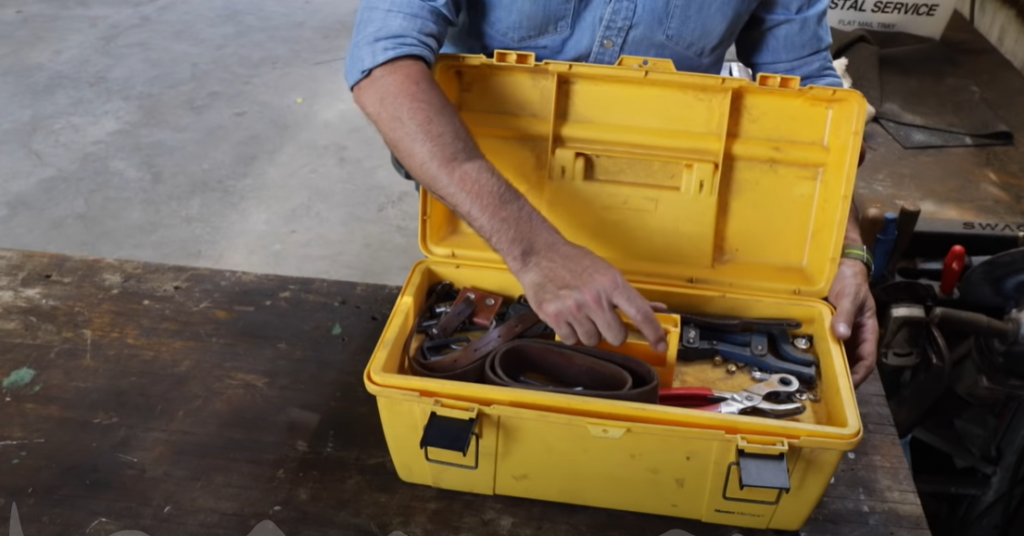
Tips And Hacks For Your Tool Box
Organizing a tool chest can be a daunting task. But with the right tips and tricks, it doesn’t have to be! Keep your tool chest orderly and always prepared with these helpful tips:
- Sort Your Tools by Function: Start by grouping all of your tools by their primary task. Put together a tool box for carpentry and woodworking, another box for plumbing, and so on. With this, you can immediately pinpoint the right tool for any given task without breaking a sweat.
- Separate Small Tools: Make sure to divide up small tools like nails and screws into individual compartments so you can easily find them when you need them. Labeling the compartments with a marker will also help keep things organized and easy to access.
- Use Containers for Odd-Shaped Tools: To make sure that oddly shaped tools like wrenches, hammers, and screwdrivers don’t get mixed up, put them in containers that are designed specifically for those tools. This will make it easier to retrieve the right tool quickly and keep your work area looking neat and organized.
- Label Everything: Make sure to label all of your tools so you know exactly what they are and where they belong in the tool box. This will help you easily find the right tool when you need it and ensure that your tools stay organized. [5]
FAQ
What should be in my tool bag?
Your tool bag should contain the essentials for your trade, such as wrenches, screwdrivers, pliers and hammers. It’s also a good idea to include multiple sizes of each tool in case you need something that’s slightly different. Other handy items to pack are duct tape, electrical tape, and various types of fasteners. It’s also beneficial to add a flashlight and small mirror for those hard-to-reach places.
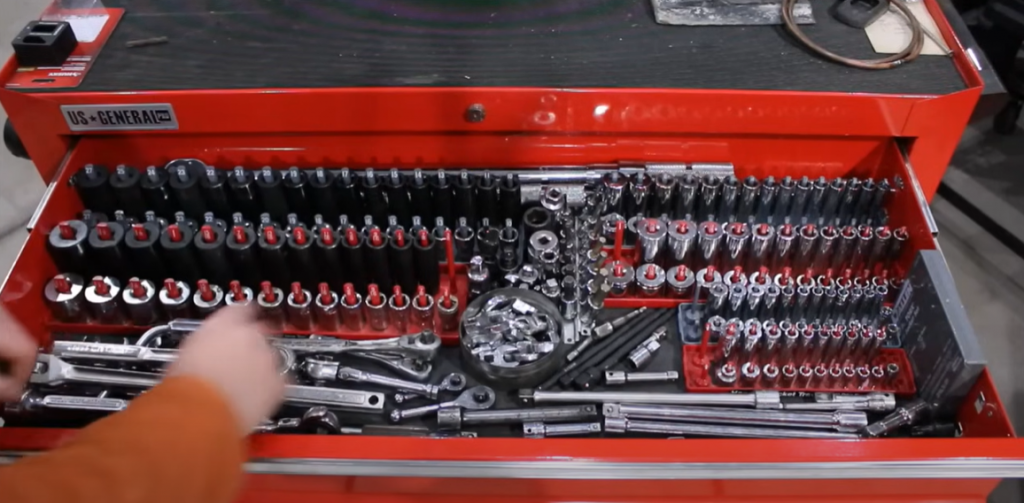
How do I organize my tools without a toolbox?
Organizing tools without a toolbox can be done in many different ways. One of the most popular methods is to use adjustable shelves or pegboard systems. This allows you to customize your storage space and put tools in an orderly fashion for easy access. You can also install wall-mounted racks and hooks, which are great for hanging power tools, wrenches, and other larger tools. Bins and baskets are also great for organizing small tools like screws and nails. Label everything with either stickers or chalkboard paint so you know exactly where to find everything. Finally, if you have the space available, consider investing in a rolling cart to make it easier to move your tools around the house or to a job site. With a little creativity and elbow grease, you can create an efficient storage system for your tools without having to buy an expensive toolbox.
How do you organize hardware and tools?
Organizing hardware and tools is an important part of keeping a well-maintained tool chest. Here are some tips for organizing hardware and tools in your tool chest:
- Start by sorting all of your hardware and tools into categories, such as screws, bolts, wrenches, pliers, hammers, etc. Do this by size, shape or material to make it easier to find them when you need them.
- Group tools and hardware that are used together often so they are easy to find and access.
- Label the drawers of your tool chest with tags or stickers to clearly identify what is stored in each drawer.
- Utilize storage trays to keep small items, such as nails and screws, together in one place.
- Consider installing dividers or label holders within drawers to help further organize your tools.
- Place heavier tools near the bottom of the chest, and lighter tools at the top for easy access.
- Store hazardous tools and materials in a safe, secure place away from children and pets.
- Lastly, clean off your tool chest regularly to keep it organized and prevent it from becoming cluttered.
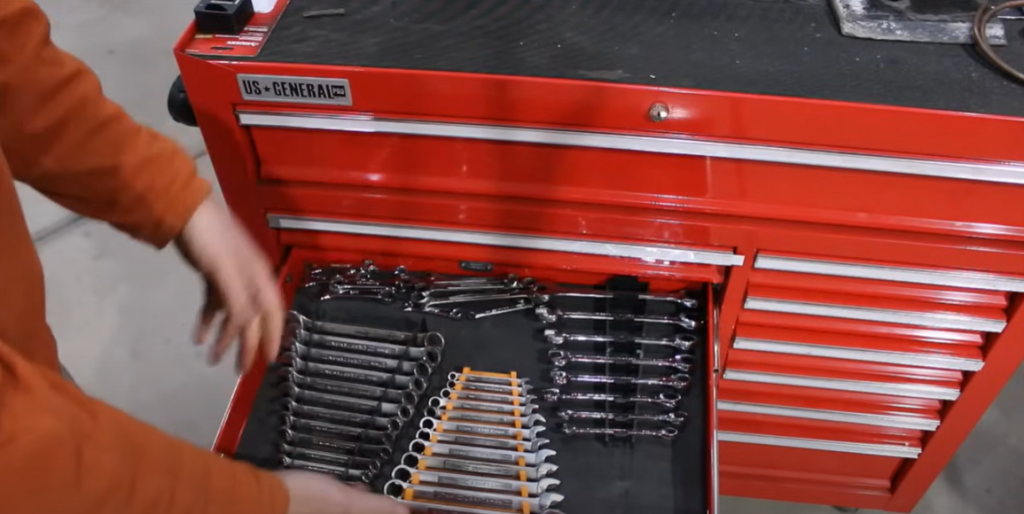
What is the first thing you should do when organizing your tools?
The first step to organizing your tool chest is to take inventory of the tools and supplies that you already have. This will help you decide how best to organize them in the chest. You should also consider whether or not any additional storage compartments or organizers need to be purchased. Once you know what items are available, it’s time to start sorting them. Start by grouping items together that are used for similar tasks, such as placing all screwdrivers and wrenches in one area and drills and saws in another. This will help you easily locate the tools when you need them. Smaller items like screws, nuts, bolts, and washers can be stored in labeled containers or drawers. It’s also a good idea to invest in a few trays with compartments so you can further divide and organize the items. Once all of your tools have been sorted into categories, it’s time to start organizing the tool chest itself. Place heavier items on the bottom, followed by lighter ones towards the top. By maintaining your chest balanced, you will have a much easier time locating the items you require. You can also use dividers or separators within the chest to differentiate between items or store multiple tools in one spot. Finally, don’t forget to label everything so you know exactly where each item is stored!
How do I organize my tools without a garage?
If you don’t have a garage or workshop space, organizing your tools can seem like an overwhelming task. But there are a few simple steps you can take to keep your tools tidy and accessible even in tight quarters. One of the most efficient ways to organize tools without a garage is to invest in vertical storage solutions. Wall-mounted tool holders and shelves are a great way to maximize storage without taking up too much space. Not only can you hang pegboard on walls for storing tools, but you can also add bins and hooks to hold smaller items such as nails and screws. Another option is to use drawer organizers to divide items in drawers. Label each organizer with the type of tools it contains, so you can easily find the tools when you need them.
Why is it important to arrange the tools properly in the toolbox?
When it comes to organizing a tool chest, the key is to have an organized and efficient system. By properly arranging your tools in the toolbox, you will be able to find the right tool when needed without having to search through piles of items. This will save you time and effort as well as make working with your tools much easier.
How do you organize wrenches in a tool chest?
Organizing wrenches in a tool chest is an important part of keeping your workspace tidy and efficient. A well-organized wrench set can help you quickly locate the size or type of wrench you need, and reduce the time spent searching for it. The ideal method to arrange wrenches in a toolbox is by grouping them based on size and function. Begin by sorting all of your wrenches into categories, such as combination wrenches or open-ended wrenches. Then, within each category group them by size. You can use dividers in the chest or drawers to help keep them separated and easy to find. Make sure you clearly label each group with a list of the sizes included. Finally, store your wrenches in a logical order that you can easily remember.
How do you organize tools in a tool bag?
Here are some tips on how to do just that:
- Begin with the fundamentals by categorizing manual tools from powered machines. With this, you’ll be able to effortlessly and rapidly find the instrument you require.
- Group items together that are related in some way, such as hammers and nails, screwdrivers and screws, or wrenches and nuts and bolts.
- Place more frequently used items at the front of the bag so they are easier to grab.
- Clearly label all tools and keep a list of their locations so you always know where each tool is.
- Dedicate one side of the bag for frequently used items, such as screwdrivers, wrenches, and pliers, and store them in an easily accessible spot like on the front flap of the bag.
- Utilize pockets for smaller items such as screws and nails, or use a pouch or zip tie to keep them organized.
- Store heavy tools in the bottom of the bag to ensure that they don’t put too much strain on the sides of your tool bag.
- Hang heavier items such as hammers, saws, and drills on the outside of your tool bag.
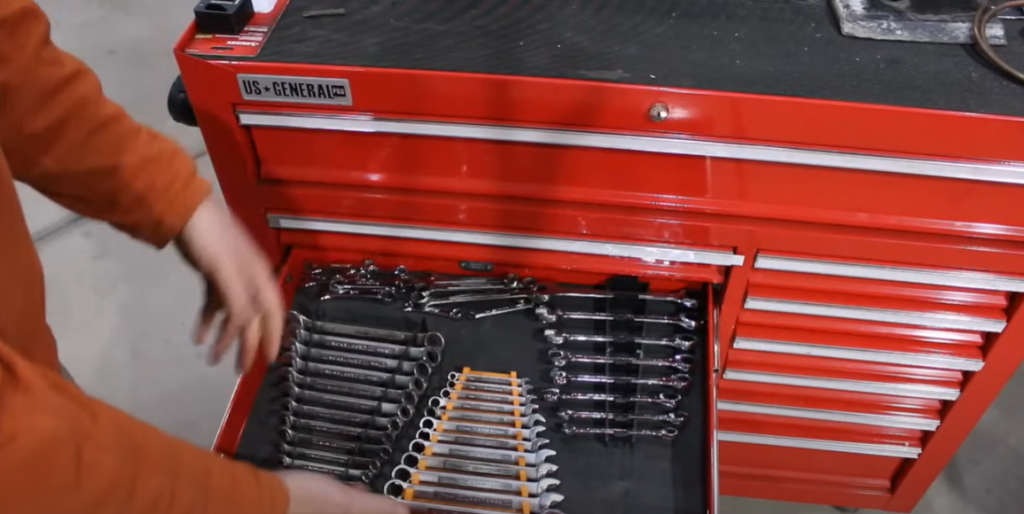
How do you organize a tool workshop?
Organizing a tool workshop can be an intimidating task, but with some planning and organization it can become manageable. A good place to start is deciding what type of tool chest storage system to use. There are many different types available, such as pegboard and drawers, workbenches and shelves, and toolboxes that hang on the wall. Additionally, specialty cabinets or carts can provide extra storage for large tools like saws or drills.
How do I organize my workbench?
Organizing a workbench is an important way to create an efficient and effective workspace. Need to get your workbench sorted? Here are some time-saving tricks for keeping it neat and orderly:
- Start by separating your tools into categories, such as cutting tools, measuring tools, fastening tools and power tools. You’ll have no trouble locating the correct tool for your needs with this!
- Keep commonly used tools within reach and accessible with a pegboard or other storage solution.
- Hang your measuring tapes, hammers, screwdrivers and level on hooks or loops so they are always easy to find and grab while you work.
- Use bins and drawers to store smaller items, such as nails, screws, and washers.
- Use labeled jars for small parts such as nuts and bolts so they don’t get lost in the shuffle.
- Store larger items like saws, drills, routers and sanders on shelves or in hangers when not in use.
- Designate a space for supplies such as sandpaper, rags and polishes.
- Finally, invest in a good tool chest to keep your tools safe and organized.
Useful Video: Watch This Before Organizing Your Toolbox
Conclusion
Organizing a tool chest is essential for maximizing the efficiency of your work. By taking the time to properly organize each tool in your chest, you can easily find any tool you need and keep your tools safe and secure. Try using dividers, bags and bins, or even magnetic strips to help organize various types of tools. Having separate storage solutions for large and small tools can also help you better access the tools when needed. Investing the time to correctly sort through and arrange your tool chest will guarantee that you can swiftly locate any necessary instrument. With proper organization, you’ll be able to tackle any job with ease!
References:
- https://www.bobvila.com/articles/how-to-organize-a-tool-box/
- https://decked.com/blogs/decked/how-to-organize-a-toolbox
- https://www.creativesafetysupply.com/content/education-research/101-tool-foam-organizer-hacks/index.html
- https://shopgraytools.com/blogs/news/how-to-organize-your-tools-inside-your-toolbox
- https://thetoolscout.com/how-to-organize-a-tool-chest/

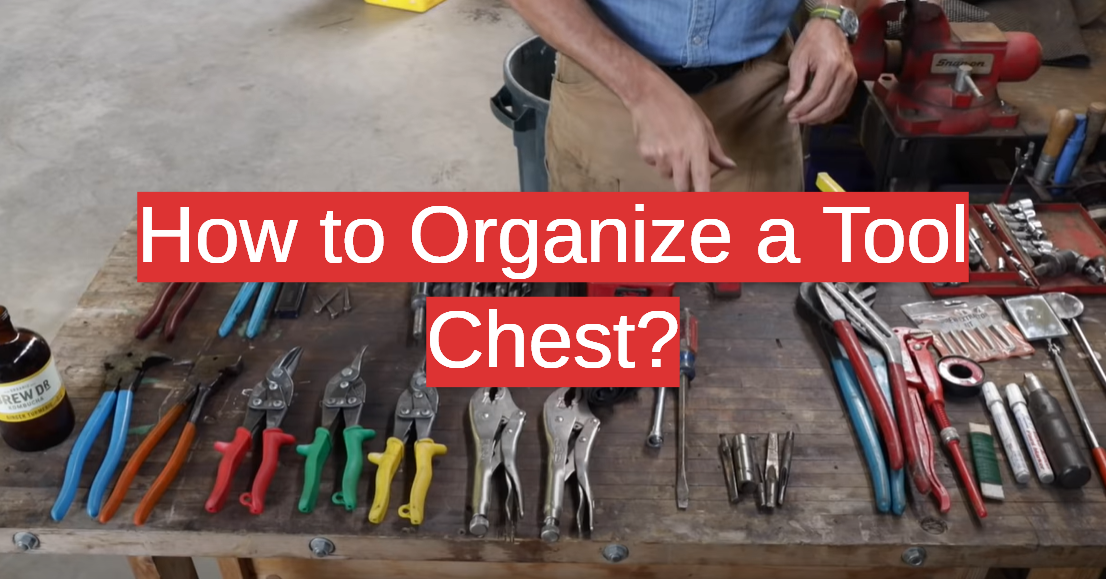

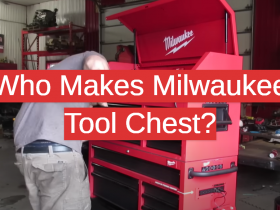



Leave a Reply